One [of the two kinds of fantastic fiction], most often seen in horror novels and movies, offers up a reality which has to be accommodated or exiled by the status quo it is attempting to overtake. Sometimes, as in any exorcism movie—and most horror movies are that, by other names—the alien thorn is successfully removed from the suppurating flank of the real. On other occasions the visitor becomes part of the fabric of “everyday” life. Superman is, after all, an alien life form. He’s simply the acceptable face of invading realities.
The second kind of fantastique is far more delirious. In these narratives, the whole world is haunted and mysterious. There is no solid status quo, only a series of relative realities…
— Clive Barker (1990)
You’d expect a report on the new round of highly pathogenic avian influenza spilling over into mammals and humans to begin with a just-the-facts update.
That’d be good practice. And we’ll get there. But to start with such an encapsulation would serve only to miss the point of the latest epizootic episode, much in the way the near entirety of the press corps has in splattering H5N1 all over us. And just off its role in burying the still circulating COVID-19.
To understand this bird flu, we need to begin elsewhere, indeed on other topics entirely. We must begin with a different flub, one we hope tips in our favor.
One of the dangers of giving an informal lecture is that even with notes one is writing a first draft with your mouth.
In ending a recent workshop on modeling collective COVID choice, I offered that, however generous in connecting governance to people’s everyday lives, Nobel Prize winner Amartya Sen’s (and Kenneth Arrow’s) logic system around societal decision-making embedded itself in the expansive liberalism of the 1960s. We can connect reason and civil society, the modelers argued.
That sounds well enough. Where’s the problem in such an objective?
Liberal governance mid-century cared about democracy and welfare economics only to the extent that they together helped defuse rebellion against capitalism’s intrinsic expropriation. They served as social bribes.
Once the U.S. empire began to wilt on the far side of the cycle of American accumulation, the nomenklatura who followed folded away even this utilitarian generosity. Keeping the machine running unimpeded now involved, on the one hand, sharper forms of labor discipline and, on the other, assistance largely in ridiculous lines of expensive credit as just another market into which capital expanded.
That is, despite liberalism’s postwar political dominance, such a politics represented only one descendant of the celebrated Enlightenment. Lost twins abounded. The Fordism of Auschwitz-Birkenau, for instance, hideously. And neoliberalism, Kenyesianism’s flashier (and nastier) younger brother.
Farther off the road, indeed much more the enemy, there was also an array in Red Reason, represented, for instance, by a line of followers of Spinoza and Hegel. These objected to the eclecticism of the postmodernism children of fascistic Heidegger and Nietzsche. They claimed using rationality for the direct benefit of everyday people.
Grand narratives, the Reds argued against the postmodernists, aren’t grounds for self-sabotage, but the bases of dialectical biologist Richard Levins’s version of living Marx’s 11th thesis: Against all efforts to infer colonial expropriation as the natural order of things, we can practice a science for the people that fights for a fairer redistribution in wealth and resources. We can fight for a better world global North and South that against capitalist cant is well within our grasp.
Here lies the flub. I ended the lecture in a joshing offhand that in the spirit of such rationality perhaps the guillotine of revolutionary Paris served as a different kind of calculator. It was only upon circling back long after the Brady Bunch windows of the workshop winked away into the Zoom afternoon that I decided that last remark was a joke.
*
In short, yes, we need to try to remember the long haul in how we arrived upon our protopandemic moment. The 24-hour news cycle around H5N1 or Biden vs. Trump or any other ahistorical kerfuffle is a punishing reset of a Memento amnesia.
We know any synthesis of an historical moment of whatever length of origin is surely something other than its components. One thinks of the silly graphic of the snake swallowing an elephant to become a sauropod dinosaur.
In the other direction, however, these now passing contributions to such a Hegelian dialectic remain remembered by those who followed the history how we got here. We remember the snake. We remember the elephant. We still see them as they were. It’s what gives the synthesis its frisson.
Concern over possible pandemics comes in more regular waves than actual outbreaks. That should be considered a good thing. A deadly pandemic every couple years just seems horrific. I’ve learned over 25 years of tracking bird flu, however, the danger may also be in the alerts serving more to absolve the world system from acting on the alarms.
I named the problematic at the very start of The Fault in Our SARS:
Each “surprise” that the virus refuses to cooperate with such hopium, acting in its own interests instead of ours, also serves to protect the system from the implications of its refusal to act. These surprises—pretending we don’t know what we know—are themselves an ideological project. The logic of fantasy remains stuck to the logic of production. The business of governing a system in decline, after all, is about managing expectations. All is well, get back to work, until, suddenly, it isn’t, as it always was.
A related if slightly orthogonal condition is presenting a crisis mentality as a form of competence. We wrote during West Africa Ebola of the uses emergencies served in boxing out structural interventions:
Emergency responses are critical, of course, but such logistics are an indirect, if perhaps in most cases unintended, means by which to avoid addressing the greater foundational contexts driving the emergence of diseases. That is, however critically unaware its practitioners, the omission serves as an ideological design feature partial to the present political and economic orders.
With the resulting damage embedded one into the other:
Commoditizing the forest may have lowered the region’s ecosystemic threshold to such a point that no emergency intervention can drive the Ebola outbreak low enough to burn out. Novel spillovers suddenly express larger forces of infection. On the other end of the epicurve, a mature outbreak continues to circulate, with the potential to intermittently rebound. In short, neoliberalism’s structural shifts are no mere background on which the emergency of Ebola takes place. The shifts are the emergency as much as the virus itself.
Do not mistake our meaning. We all must continue to pronounce the obvious until the dreamers are shook awake (or the schemers shook off). Otherwise, as I wrote in Big Farms Make Big Flu, our cynicism flatters us into inaction. Another kind of somnolence to avoid, this one of our own ostensible opposition.
*
But the core complication remains whether or not we embrace such a Gramsician optimism of the will.
Social epidemiologist Gregg Gonsalves’s latest identifies a variant on this peculiar American penchant for gilding a turd. Which, at this end of the cycle of accumulation, will be the imperial standard here on out.
Gonsalves finds in the liberal moment an anti-empiricism pretending away COVID in the way New Yorker religion writer Emma Green weaponized against the People’s CDC in late 2022. “On the one hand,” Gonsalves writes,
we’re getting a triumphalist tribute to our performance during the first four years of the (ongoing) pandemic. At the same time, we’re being told we got it all wrong in our response to Covid. Either way, these narratives don’t bode well for our future.
The best and brightest are now found at these Biden barricades:
First, we have David Wallace-Wells’s New York Times piece on “Who ‘Won’ Covid.” I mean, OK, it’s a little ghoulish to horse-race this after more than 1.1 million American deaths (a number that is likely an undercount), but Wallace-Wells’s bottom line is that hey, we’re not Uganda, Zambia, Chad, Zimbabwe or Mozambique. Or, as he says, the U.S. is “nevertheless closer to the world’s best performers than its worst ones.”
This “nevertheless” carries a lot of weight for Wallace-Wells, because compared to our peer nations in the G7, there is not much to crow about: We did terribly. He acknowledges this, but assures us that, “nevertheless,” we did good, people. Yay. The piece is designed to obfuscate, not elucidate. After reading Wallace-Wells, I feel like we’re winning so much, I am now quite tired of winning, as the oracle of Mar-a-Lago predicted so long ago.
From COVID to Palestine, fascism, a death cult, isn’t a political party. It’s a social formation wherein the political class of both parties stateside redirects the accumulating rage at a program organized around helping the rich cash out on the last of the public commons—redirects it upon the poorest and most vulnerable.
Gonsalves disabused me of my sore hope that a colleague hadn’t taken up the reins helping the gallop right through the Overton window:
Our last example of Covid revisionism comes from inside the house, in a compilation of essays by Sandro Galea, the dean of the Boston University School of Public Health. His new book, Within Reason: A Liberal Public Health for an Illiberal Time, chastises his peers in a way that seems off the mark.
First, Galea suggests that public health “got political” during the pandemic, in part as an overreaction to “an empowered right-wing and the Trump administration’s frequent hostility to public health.” This is a deeply ahistorical reading of public health, one that fails to recognize that it has always been political. From its roots in the Industrial Revolution, public health has oscillated between a progressive vision, which was represented by pioneers such as Rudolf Virchow and Friedrich Engels, and a far less liberal one, in which, as Yale historian Frank Snowden has said, “urban cleansing took on a figurative as well as a literal sense, and was seen as a potential solution to the threat posed by the ‘dangerous classes.’”
This dialectic has persisted in public health since its start; I fear that Galea’s idea of a space free from politics hides a less-than-objective predisposition. It’s meant to claim a specific viewpoint as neutral and true…
And on whom does liberal Galea glom during these illiberal times?
Galea has a soft spot in his book for the Great Barrington Declaration, an open letter published by lockdown skeptics in October 2020. He’s fond of it not because, he says, he believes in its assumptions or prescriptions but because the rest of us tried, judged, and convicted the authors in the court of public opinion instead of judging it scientifically. Galea fails to mention that the Great Barrington Declaration was not a scientific manuscript, but a document issued by a right-wing think tank. It was never proposed for scientific review…
I may have mistaken Galea hosting then-CDC director and soft eugenicist Rochelle Walensky as a combination of a dean’s obligations to his school and ten-dimensional chess to maneuver the political class back to practicing—rather than violating—public health. As, in contrast, I think Steven Woolf tries in two excellent attempts (here and here) in the American Journal of Public Health.
“So much of this, as other writers have said,” Gonsalves explains,
is about class in America. The [New York] Times’ Covid coverage has frequently tilted toward the needs of white and wealthy readers—ones who could sequester away at home or in their country houses during the height of the pandemic, whose kids went to schools with new ventilation systems and Covid testing and for whom the pandemic response was just good enough (we’re not Uganda!). For others like [NPR apostate Uri] Berliner and Galea, there seems to be a deep need to lean into power in its ascendancy—that is, to show conservatives that they have a friend, with support for the lab leak theory and the Great Barrington Declaration meant trot out their bona fides.
“Except,” Gonsalves follows through on the implications for global health,
this all makes us more vulnerable to the next pandemic, by suggesting that mitigation efforts were overzealous, not supported by the data, did more harm than good, and were “just political,” and that what happened to us was not so bad in terms of international comparisons. And the obsequiousness with which some try to gain the favor of conservatives shows a real misreading of the threats coming for public health from a possible Donald Trump presidency, ongoing attacks on public health at the state and local level, and a willingness to play fast and loose with the data.
The aforementioned Dick Levins, in whose lab Galea served as a postdoc, would have been disappointed.
*
So that’s something of the delayed differentials of the postwar histories leading up to bird flu’s latest round. And why their absence is nigh on unethical in today’s breathy reporting on H5N1. We can’t really understand what this bird flu means otherwise.
Since 1997, highly pathogenic avian influenza H5Nx set off repeated if unevenly distributed deadly outbreaks in poultry and humans (CDC’s Figure 1 here). H5N1—long reassorted into something different from its early days in Hong Kong (see Xie et al.’s Figure 1 below)—appears the primary serotype threatening to go human-to-human.
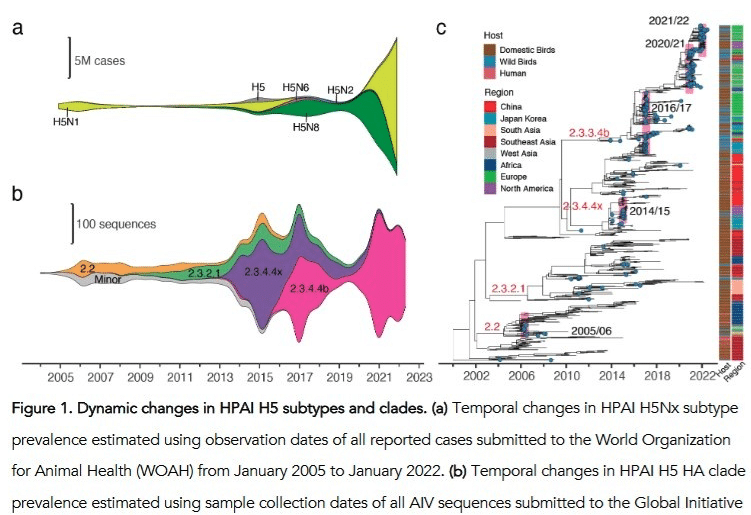
The past two years, today’s major H5N1 clade 2.3.4.4b has expanded its scope of mammalian species infected (and killed).
Disease ecologist Marius Gilbert recently graphed the HPAI H5Nx found in wild birds and mammals by the numbers of species infected and the outbreaks per year across three time periods, 2003-2024.
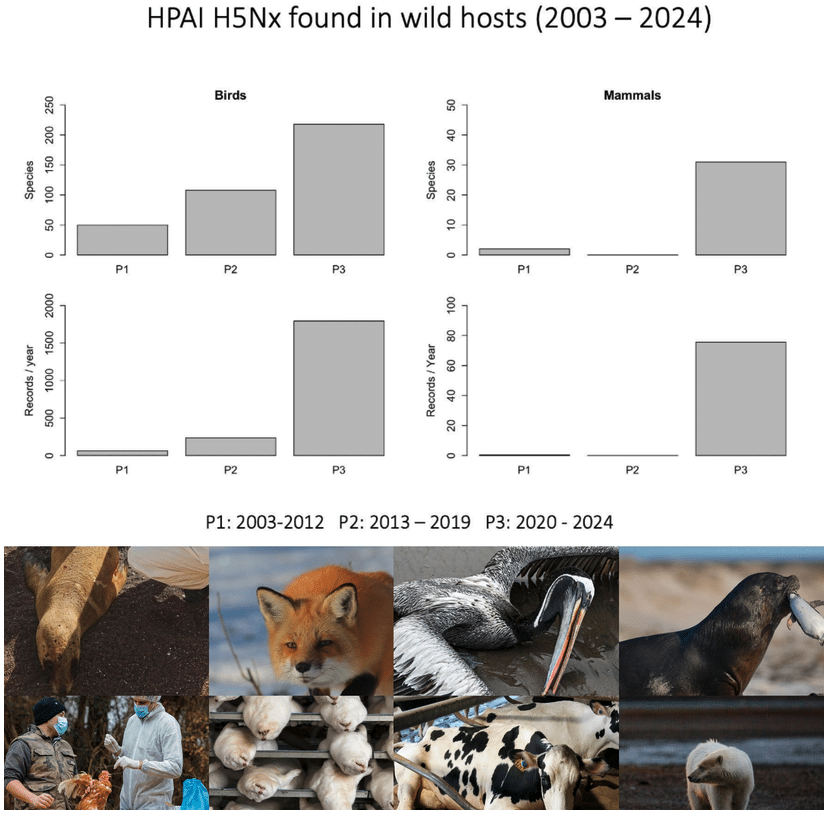
The data are sourced from the Food and Agriculture Organization’s EMPRES-i geo-coded disease database. Gilbert used ChatGPT to collate the variety of common names into species names.
We see a clear surge in taxonomic exploration, likely permitting the HPAI variants a wider expanse over which to experiment with solving the mammalian immune system for epidemic transmission.
Yes, as I previously wrote up, a matter of farming pathogens one diseconomy of scale atop another. The bigger the agricultural operations from farm to circuits of capital, the worse the epizootic damage in evolved virulence and numbers of animals affected.
But the protopandemic here is also tied to a lucrative refusal to grasp the capacity influenza and other pathogens have for patiently exploring their adaptive landscapes.
On the one hand, there may be some evolutionary logic gate the H5Nx can’t breach, including compensatory evolution across its proteins. On the other hand, the variants have been experimenting steadily on the problem across millions of their own “lab” animals farm-to-farm and lake-to-lake for the past thirty years.
H5Nx’s “data farming” across continents is by far a larger and faster operation solving the mammalian calculation than the public health efforts global governance was long abandoning the past four decades. And in an accelerating fashion during the libertarian rejection of the COVID-19 response.
*
But what to do with these signs and wonders?
The H5Nx have been circling around mammalian infectivity since 1996 and likely earlier. Many teams have attempted to search for molecular signals that might speak of an imminent outbreak.
We tried our own hand in unpublished work I conducted with statistician Hal Stern in 2008. Stern and I mapped out where H5N1 strains appeared closer to a human-specific infection, using a nucleotide substitution bias in favor of anti-sense uracil previously shown in the polymerase loci.
We found the initial Hong Kong outbreak in 1997 with some of the highest human-specific influenza U concentration recorded, perhaps indicating humanity likely dodged a pandemic bullet then. The mean polymerase U concentration subsequently declined before creeping up again by 2007. And we identified an anistropic distribution to U bias, with some places across Eurasia closer to human specificity at that time than others, with,
a peak in southern China [increasing] again north along China’s east coast. Another gradient ascends westward, with outbreaks near Moscow, in the Black Sea basin, and in the Persian Gulf region with the greatest mean uracil content.
What might that mean for mechanism and intervention?
Several localities with greater avian uracil content also show greater human-specific U, suggesting local upticks entrain multiple host types. We propose that a stochastic bump across a threshold in polymerase uracil content in one of an increasing number of affected localities is another mechanism by which a pandemic may emerge. Tracing the geographic distribution of viral phenotypes can help define alternate mechanisms of disease emergence as well as better target locale-specific interventions.
Promising. But some of a scientist’s best work goes incomplete or unpublished. And that’s damage a society incurs when it doesn’t pay its people.
So even now seventeen years later, I can’t speak to whether such a uracil bias could offer such a tip-off. Generally, other such efforts, Global Biodefense writes, have been humbled:
Influenza viruses are believed to have sparked at least 14 human pandemics in the past 500 years; the most devastating of which began in 1918. Yet, despite intense study and considerable advances in public health, virus surveillance and virology, there is no simple answer to this pressing question: when and how will the next flu pandemic arise?
NIAID scientists consider the many potential pathways to future influenza pandemics in a new viewpoints essay in Science Translational Medicine. There are no hard and fast ‘rules’ specifying, for example, what characteristics a given avian influenza virus must possess to allow it to efficiently infect people and other mammals, the authors note. Instead, “current and historical evidence suggests that pandemics result from highly variable, and extremely rare, viral adaptational phenomena that can be understood only in hindsight.”
The team falls back on “need more research” and the kind of lab-based preventative efforts they’re familiar with (and well-remunerated for):
In the face of this humbling reality, the authors conclude, preparation for future pandemics must include basic research into ‘host switching’ and how the virus adapts to new hosts; expanded surveillance of viral emergence at the animal-human interface; and continued efforts to develop broadly protective vaccines.
As we described previously, such a program misses the preventative efforts a healthy public health system neoliberalism has abandoned requires.
That’s the short term of ten to twenty years that electoral cycles and quarterly profits can’t even handle. The long term involves significant regime shifts in the agriculture, forestry, land use, and other modes of civilizational reproduction the political class and the rich they serve have no interest in changing whatsoever save in bankable disruptions often organized around monetizing parts of planet or person.
It’s easier to imagine the end of the world, philosophers Fredric Jameson and Slavoj Žižek stole from H. Bruce Franklin, than imagine the end of capitalism.
So, in short, it’s unclear whether H5N1 clade 2.3.4.4b and other H5Nx are marching inexorably toward finding a solution to human transmission or whether synergistic barriers across biocultural levels make the leap beyond intermittent spillover too hard a problem.
Maybe a bit of both. But neoliberal leaders, whatever the sporadic concern, always bet on the second because their countries are no longer organized around servicing the public commons. Y’know, the basis of any society aiming to continue beyond its present generation.
The deets on which journalists and disease trainspotters online are so focused matter, but only inside the greater context with which we began.
After nearly a decade attacking the industrial poultry land-grant professors swore were immune, the novelty of this spillover, Thao-Quyen Nguyen and colleagues summarize in the figure below, is that H5N1 arose likely in December 2023 in dairy herds, a new path into the food supply. Veterinarians reported declines in milk production in January and sent samples in to the feds.
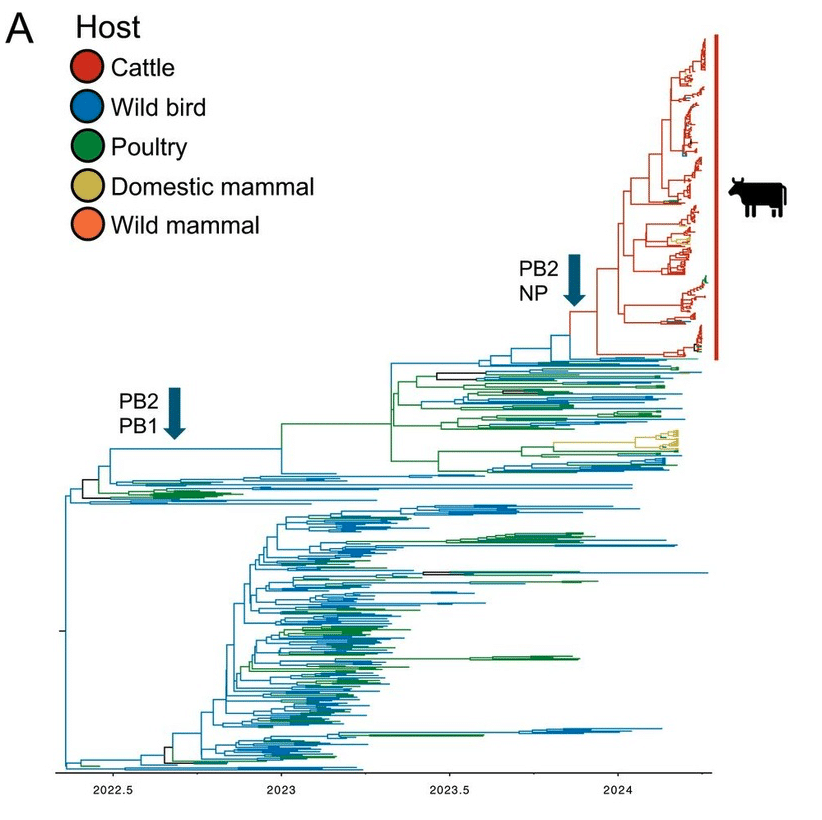
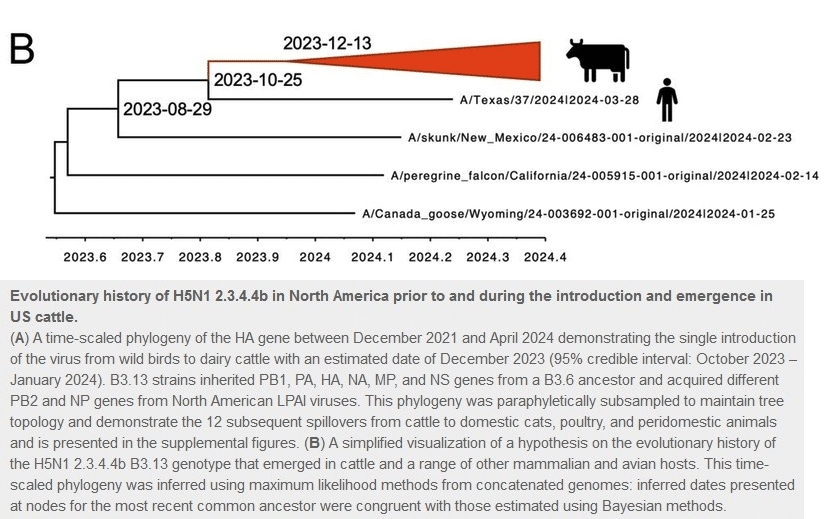
Since late March, H5N1 has been recorded spilling over stateside into at least 36 cow herds across nine U.S. states—see the other Nguyen figure below—with the virus detected in milk and in farmworkers. With one veterinarian in Texas reporting nearly every dairy farm hosting cow H5N1 also hosting worker infections:
“We were actively checking on humans,” Petersen said. “I had people who never missed work, miss work.”
So far, two people in the U.S. have been confirmed to be infected with H5N1, most recently a Texas dairy worker linked to the cattle outbreak, according to the U.S. Centers for Disease Control and Prevention. About two dozen people have been tested and about 100 people have been monitored since the virus appeared in cows, Dr. Demetre Daskalakis, a CDC respiratory diseases official, told reporters Wednesday.
Daskalakis said CDC has seen no unusual flu trends in areas with infected cows, but some experts wonder if anecdotal reports of sick workers mean more than one person caught the virus from the animals.
Petersen said some workers had symptoms consistent with flu: fever and body aches, stuffy nose or congestion. Some had conjunctivitis, the eye inflammation detected in the Texas dairy worker diagnosed with bird flu.
It’s the kind of noisy syndromic signal that Smithfield Foods used to dismiss its putative role in launching the swine flu H1N1 pandemic off a subsidiary’s hog farm outside Mexico City in 2009.
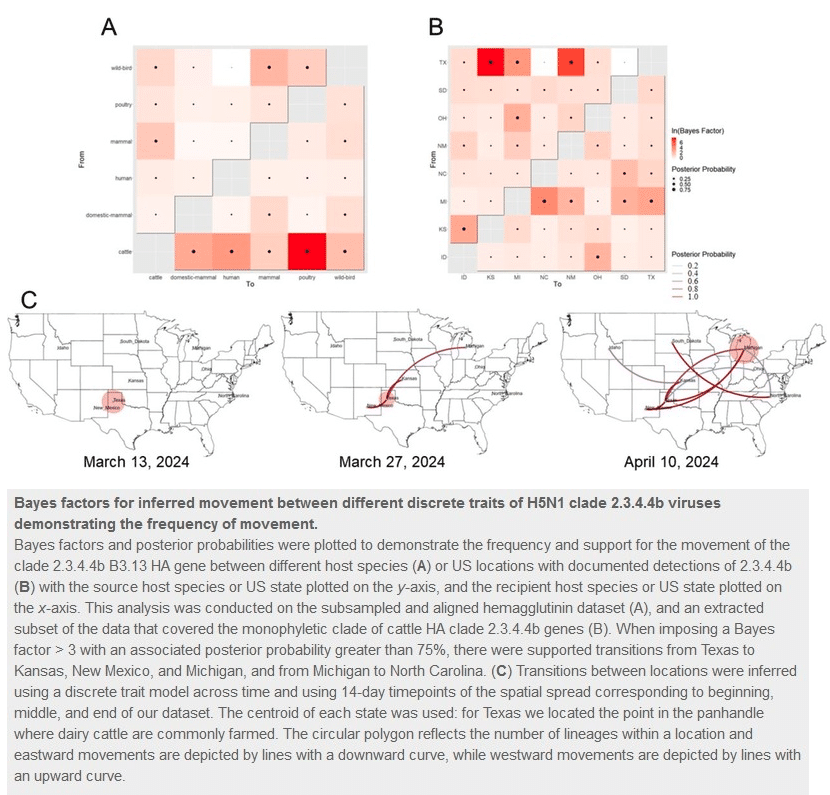
USDA officials reported raw infected milk killed a dozen cats, but the FDA followed up that pasteurized milk wasn’t a human danger.
Virologist Rick Bright, a gadfly during COVID, questions here and here the quick turnaround arriving upon such a conclusion about milk’s human risk. Virologist Marc Johnson waves away the concern. He also thinks the danger will be found only when this H5N1 enters hog, but Bright cites preliminary work that shows cows themselves capable of serving as an appropriate mixing vessel for H5N1 and human influenzas reassorting genes for H2H infection.
Not all infected herds were linked to others in the dataset, indicating other herds in the transmission chain remain unidentified. And those likely number in the tens if not hundreds, with infections concentrated in herds in Texas—the apparent point of origin—Kansas, Michigan, and New Mexico.
With livestock privacy better protected than humans’, these dairy cases are being reported publicly only at the state level although their local areas can be roughly inferred given milk cow inventories.
The phylogenies identify accumulating mutations in the cows researchers suggest increase transmissibility while spillovers have been reported back into wild waterfowl, poultry, domestic cats, and raccoons.
The vaunted wastewater surveillance replacing the case counts the feds seem now incapable and unwilling to conduct at scale can’t distinguish Influenza A by subtype. The map here for the week of May 4 can parse neither HPAI from seasonal influenza, nor human from livestock sources.
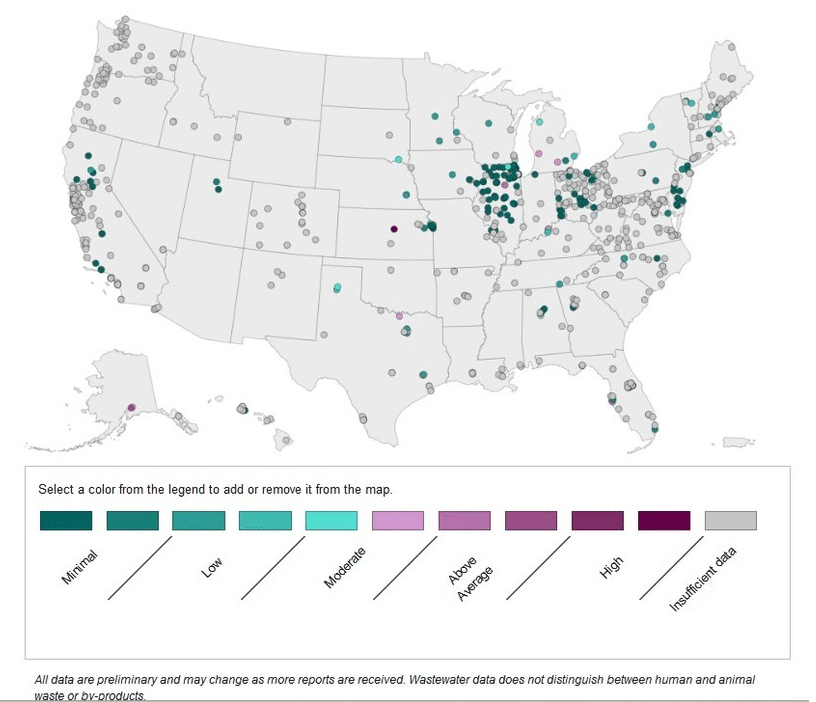
COVID celebrity scientist Michael Mina reports with Janika Schmitt at Time Magazine:
The H5N1 outbreak in dairy cows is widespread and spans multiple U.S. states. Although only one human infection with the virus has been documented, more infections are likely going undetected. Most importantly, unchecked transmission among cattle means the virus is increasingly bumping up against humans. Every human exposure, in turn, provides an opportunity for new mutations that could enable human-to-human transmission.
Harking right back, as Mina and Schmitt put it, to the willful incompetence of early COVID:
Despite the high stakes, government action initially has been slow and uncoordinated. Until mid-April, testing was not only voluntary but restricted to symptomatic animals, with limits on the number of tests per farm. A complicating factor is that responsibility for outbreak control is divided between three federal agencies: the U.S. Department of Agriculture (USDA) for livestock, the U.S. Food and Drug Administration (FDA) for food safety, and the CDC for human health and surveillance.
Yet by May, the CDC was aware of only about 30 people who had been tested for bird flu. The CDC has been monitoring data from emergency departments in areas where H5N1 has been found in cattle and has found nothing unusual so far. But if and when infected people show up at the ER, it will be way too late to contain the outbreak at its source.
Although a CDC-led team did conduct H5 wastewater analysis at three Texas sewage plants, two of which serviced industrial discharges of animal waste and milk byproducts:
Prospective influenza A (IAV) RNA monitoring at 190 wastewater treatment plants across the U.S. identified increases in IAV RNA concentrations at 59 plants in spring 2024, after the typical seasonal influenza period, coincident with the identification of highly pathogenic avian influenza (subtype H5N1) circulating in dairy cattle in the U.S.
We developed and validated a hydrolysis-probe RT-PCR assay for quantification of the H5 hemagglutinin gene. We applied it retrospectively to samples from three plants where springtime increases were identified. The H5 marker was detected at all three plants coinciding with the increases. Plants were located in a state with confirmed outbreaks of highly pathogenic avian influenza, H5N1 clade 2.3.4.4b, in dairy cattle. Concentrations of the H5 gene approached overall influenza A virus gene concentrations, suggesting a large fraction of IAV inputs were H5 subtypes.
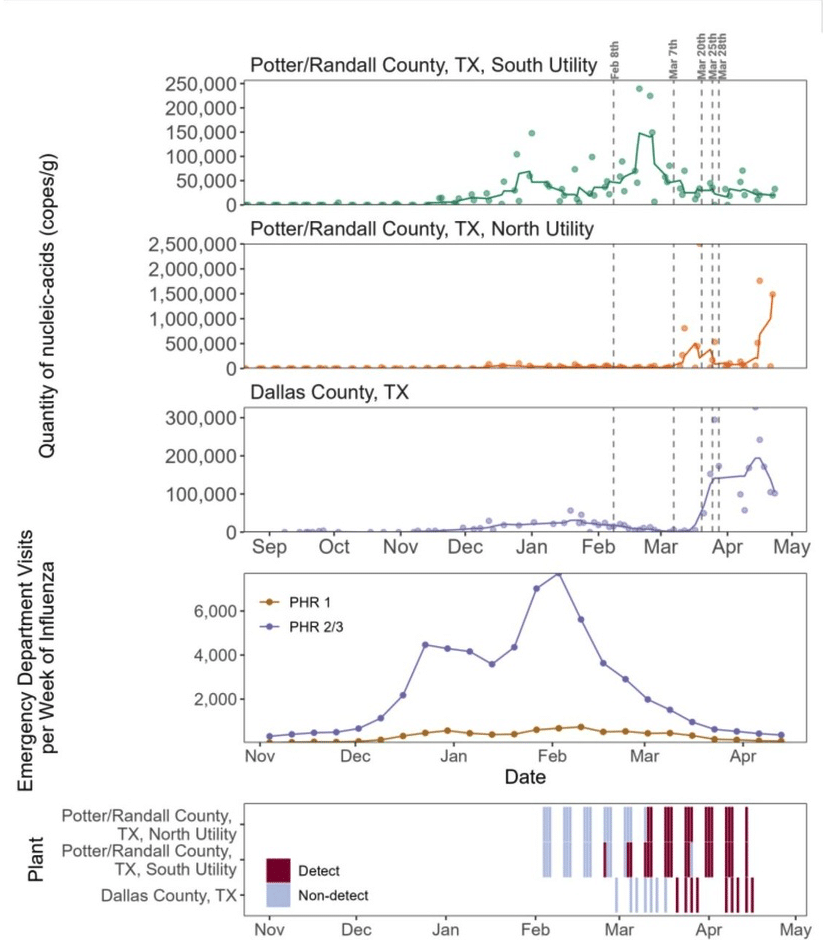

Marc Johnson posted that such a system could have all been in place nationally upon the outbreak:
If we had a pan-influenza wastewater screen in place nationally that differentiates the influenza sources by sequencing (which isn’t that hard to do), we probably would have detected this outbreak months ago.
We submitted a CDC proposal earlier this year to do exactly this, but the topic was pulled from the [Board Agency Announcement] so the proposal wasn’t even reviewed.
Mina and Schmitt finish off proposing the kind of Swiss cheese model of multiple testing and intervention regimens the CDC abandoned for COVID-19 as a matter of principle:
The recent federal order requiring mandatory testing of dairy cows before they cross state lines is a step in the right direction. But we could be doing more: we should incentivize testing, rather than restricting it. A layered testing strategy that combines waste or wastewater surveillance on the farms, routine testing of pooled milk from the cows, and active surveillance testing of animals and humans—including those without symptoms—is our best hope of stopping the virus from spreading…
Along with all the human testing and tracking—Mina and Schmitt indulge in the disastrous “we have the tools” language on which the Biden administration hung its COVID abandonment—these efforts need also be put into a social context:
The government must also address the stigma associated with positive test results and provide financial aid and resources to help affected farmers and their workers. Many of the individuals working on dairy farms are undocumented, for example. The current administration should make assurances that offer protection to undocumented workers who agree to test as a part of public-health surveillance testing programs.
Immigrant and indigent illness—including now the cow worker in the graphic at the top of the post—serves as a battle cry for the latest in right-wing-led deportation and more secular neoliberal land grabs.
Gestures toward social context are routinely performed upon the same political stage the policies that caused the damages were enacted. At the same time, agribusiness pushes back against testing at all, reenacting exactly its game plan from the H5N2 outbreak in poultry a decade ago.
One finds at such a crossroads—all directions leading to a ditch—a telling stand-off on the more than half-a-billion dollars the feds paid poultry producers to cull birds upon highly pathogenic avian influenza H5N1 outbreaks last year alone.
Last year’s subsidies included $80 million to wee smallholder Hormel’s Jennie-O and $30 million to that family farmer Tyson Foods, both still reporting billions in profits last year.
On the one hand, culling is one intervention for reducing the likelihood the HPAI spill over into humans. Animal welfare groups, on the other hand, are now contending that the subsidies support inhumane treatment on a mass scale, including the cheapest way: shutting down ventilation and heating poultry into heat stroke. Since 2022, 82 million birds have been culled. The feds meanwhile argue the subsidies encourage faster reporting in surveillance.
Pulling an argument directly out of my “Collateralized Farmers” piece in Big Farms Make Big Flu, the animal rights groups argue:
By compensating commercial farmers for their losses with no strings attached, the federal government is encouraging poultry growers to continue the very practices that heighten the risk of contagion, increasing the need for future cullings and compensation.
But my BFMBF argument developed matters further, along the lines of the ways corporate agribusiness used contract farmers to the companies’ advantage:
Agribusiness grows [contract] farmers as trap crops, sopping up structural diseases with externalized debt. The market protects influenzas and other pathogens inherent in raising so many birds so fast and so close together by dumping the costs of the outbreaks on contingent labor.
The animal rights groups could better make their argument by finding common ground with the farmers whose practices, yes, they object to.
But if we thought ourselves all CAFO abolitionists, these efforts could serve as the animal rights front for putting pressure on the system to end (or roll back) industrial poultry. Such a shift is not unheard of. The French did somewhat upon multiple H5Nx in 2017. The rights groups here are aiming to remove the moral hazard of a taxpayer cushion on every widespread outbreak the sector produces.
But folding poultry (and now dairy) farmers into more agroecological approaches would be a more effective assault on the sector’s insistence that everything is exactly as it should be.
The Times story reports California let an animal sanctuary that didn’t raise poultry for food to refrain from culling upon a small outbreak. Many birds there, even sick ones, survived, permitting, as we argued in BFMBF and Dead Epidemiologists, those birds left over the immunity they need to fight off a still circulating infection.
Scaling out such an approach would require radically restructuring the food landscape, including reintroducing a wide range of agrobiodiversity and allowing poultry to reproduce on-site. In other words, the kind of natural economy the industrial model has long aimed to destroy as it turns nature’s “ecosystem services” into fictitious commodities that eat away at farmer revenue.
Instead, a program for compensating farmers for testing and treating cows is to be launched this outbreak. Necessary perhaps, but its shortsightedness is also the point.
“If you wanted to create the ideal environment for fostering the mutation of pathogens, industrial farms would pretty much be the perfect setup,” the Times quotes Gwendolen Reyes-Illg, a scientist at the Animal Welfare Institute who focuses on meat production.
“Our world,” I wrote In Big Farms eight years earlier,
is encircled by cities of millions of monoculture pig and poultry pressed alongside each other, an ecology nigh perfect for the evolution of multiple virulent strains of influenza.
I’ve repeatedly deployed similar lines elsewhere.
Credit or no, it’s nice to see my point has seeped into the cultural substrate. Not sure whether that will help anyone, however. Whether bird flu is on the march (or the meander), the monomaniacal focus of so many across agriculture’s political continuum, isn’t the right question.
The foundational problem here, then, isn’t this stranger of a virus. The political class—today from AOC to Genocide Joe and AIPAC’s Tom Cotton and beyond—maneuvered us into a splatter of structural blind spots of its own making. We are unable to see epidemiological causality as a matter of principle.
Lucrative new drugs or updated vaccines or more research won’t be enough to remove Clive Barker’s alien thorn. For it isn’t alien. It’s the system itself.
Native American sci-fi writers have tried telling us this, commenting that the apocalypse already happened. They’d know. Others don’t. To their grand recompense.
The chattering class is finding its latest serotonin-dopamine fix in the next H5Nx threat. Their jonesing misses that the present regime already failed its test under a still ongoing pandemic. Indeed, COVID only turned libertarianism’s abandonment of the very concept of public health mainstream—from far right through the center to the far left. It’s everywhere now. From the Proud Boys to Boston University.
In contrast to Minnesota’s low-bar affirmation that the state could declare a public health emergency during a pandemic, the North Carolina Senate Judiciary Committee sent a bill for full Senate vote to ban masking even for public health reasons. The bill is now up for a full vote in the NC Senate, carving out an exception for the KKK. Ostensibly the legislation aims to punish college students protesting the Palestinian genocide, as if masking at the peaceful encampments were solely about hiding identities and not protecting each other from COVID.
Such shifts in the zeitgeist mean objections barely holding on are themselves hobbled. The undergrad here given access to the Times op-ed page makes a noble effort to connect the bird flu dots, save the ones that matter.
If you want to stop a virus primed to kill a billion people, you’ll have to replace the present system. Including at the Times. No new vaccine or mask mandate or animal rights or conservation program the rich have already captured will be enough. We’ll have to junk these relations of production in favor of creaturely ecosocialisms region by region.
Otherwise, if the present genocide hasn’t clued you in, the comprador class North and South are prepared to sacrifice all whom they deem unuseful. They are even now enclosing the bedrock of our natural order—clean water, what fertile soils remain, temperature itself—to the last gulp of plague-free air.
Are we prepared to snap out of the fog of their necromaniac assurances? Are we ready to reject the rearward model that emergencies are to be addressed only after the fact? Are we set to save our own lives from those blithely fixed upon sacrificing them?
It turned out later in our collective choice workshop we learned that the grand liberal Sen himself gave my joke all due consideration:
The angry crowd which, on 14 July 1789, responded to de Launay, the governor of Bastille, by shouting, ‘Down with the second drawbridge!’ was involved in a collective choice of a somewhat different kind.
Article Courtesy of Rob Wallace. See Rob Wallace Patreon.

